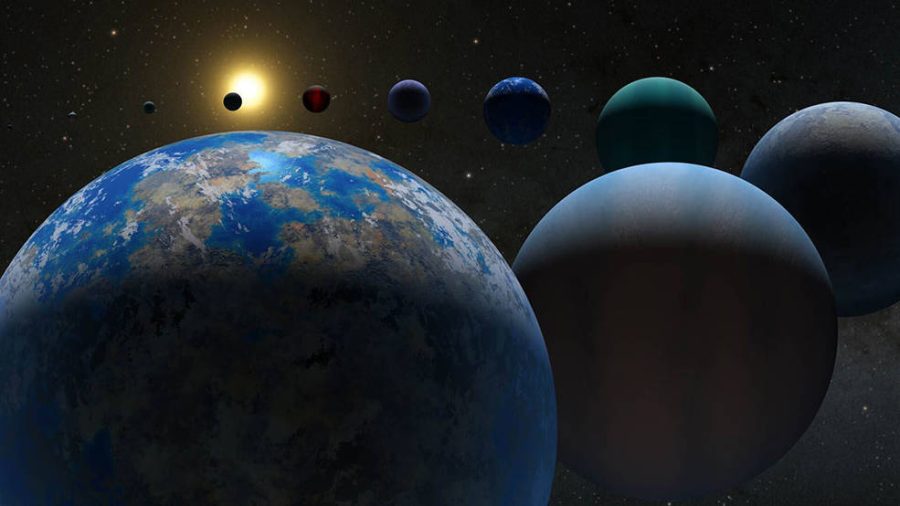NASA confirms existence of more than 5,000 exoplanets
March 30, 2022
NASA confirmed the existence of over 5,000 exoplanets in a recent announcement, marking a new milestone in their decade long search for planets beyond Earth’s solar system.
The first exoplanets were found in the early 1990s and over the last 30 years, with the use of elaborate technological equipment, astronomers have uncovered thousands of additional planetary bodies.
These discoveries began when radio astronomers Aleksander Wolszczan and Dale Frail spotted two planets orbiting a pulsar, “a rapidly spinning neutron star that pulses with radiation signals,” according to Hannah Seo of Popular Science. The publication of their findings in Nature sparked a wave of interest in exoplanet research.
All confirmed exoplanets since their groundbreaking discovery surrounding incandescent stars differ immensely and encompass very distinct attributes. Some exoplanets are gas giants while others are small and have rocky terrain.
Of the 5,000 confirmed exoplanets, 30% are gas giants and another 35% are cold and dark like Neptune.
31% of confirmed exoplanets are classified as super-Earths, which are planets that can be double the size of Earth and 10 times heavier. The remaining 4% consists of earth-sized rocky planets.
Scientists are searching for planets comparable to Earth that can sustain life and allow humans to inhabit. A suitable climate, breathable air and water are paramount when looking for signs of life.
Searching for rocky worlds with characteristics of Earth is the next step in the development of the “transit” method used by NASA scientists to discover new planets.
NASA astronomer William Borucki created the method, which involves launching telescopes with sensitive light detectors attached into space.
Once in orbit, the telescope would observe hundreds of thousands of stars for tiny dips that indicated when a planet was crossing in front of them.
NASA’s Kepler Space Telescope, which launched in 2009 and spent more than nine years in space, was their largest attempt at the “transit” method, as the telescope observed well over 500,000 stars and facilitated the discovery of upward of 2,600 exoplanets.
One of the latest uses of the “transit” method was the Transiting Exoplanet Survey Satellite launched in 2018, which has discovered more than 203 confirmed exoplanets and spotted 5,459 that are yet to be confirmed and are currently being examined.
The new extraordinary milestone marks three decades worth of discovery that has opened exciting doors for experts to redefine preconceived notions of space and life beyond Earth.
“It’s not just a number,” said Jessie Christiansen, a researcher at the NASA Exoplanet Science Institute. “Each one of them is a new world, a brand-new planet. I get excited about everyone because we don’t know anything about them.”
Plans for future explorations of exoplanets require additional technological instruments that can paint a better picture of what lies beyond Earth’s solar system.
The detection capabilities of next-generation telescopes capture light from atmospheres surrounding exoplanets. These instruments will be able to assess the presence of gases on exoplanets and determine whether the land is habitable for humans.
The Nancy Grace Roman Space Telescope is another exoplanet detection technology expected to launch in 2027. The telescope will use various methods compiled over the years to give precise depictions of the newly discovered celestial objects.
The European Space Agency’s Ariel space mission, projected to launch in 2029, will examine the atmospheres of different exoplanets. The mission will integrate NASA technology to generate a more accurate view of clouds and hazes on observed exoplanets.
NASA’s astronomers don’t plan on going to an exoplanet anytime soon because there is a tremendous amount of information they have yet to attain. Exoplanets are so distant that it could take thousands of years to reach one with the current technology available.
The next steps that NASA takes will only require human intervention from Earth until more research is done.
But NASA has hinted at potentially exploring the idea of sending a robot characteristic of a Mars rover “very far in the future,” according to CBS News.
Astronomers can attempt to predict how many planets there maybe, but they cannot determine how long it will take to find a planet that has the same inhabitable features as our rocky planet.
“Even with more than 5,000 other worlds in the books, it’s still just us,” Marina Koren of The Atlantic said.
“In fact, scientists could find 5,000 more exoplanets and we might be exactly as alone as we are now.”
Some argue, however, that the benefits of space exploration outweigh the drawbacks because there is a lot of knowledge gained through the discovery of planets beyond Earth’s solar system.
“I get a real feeling of satisfaction, and really of awe at what’s out there,” Borucki said in a NASA press release. “None of us expected this enormous variety of planetary systems and stars. It’s just amazing.”
NASA’s list of groundbreaking findings has only uncovered a fraction of planets within the expansive galaxy. Scientists predict there could be hundreds of billions more exoplanets, with some that can possibly be hospitable for life.







